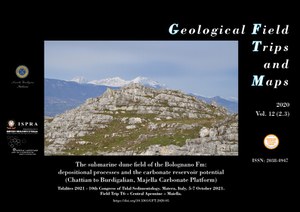The submarine dune field of the Bolognano Fm: depositional processes and the carbonate reservoir potential (Chattian to Burdigalian, Majella Carbonate Platform)
Tidalites 2021 - 10th Congress of Tidal Sedimentology. Matera, Italy, 5-7 October 2021. Field Trip T6 – Central Apennine – Maiella
This two-days field trip is focused on the Bolognano Formation, the homoclinal carbonate ramp developed on the Majella Mountain (Central Apennines) from the late Rupelian to the Messinian. The northern sectors of the Majella Mountain show excellent and continuous exposures of this carbonate ramp. In the late Oligocene-early Miocene, the paleoceanography of the Mediterranean was controlled by different seaways, one of the largest being the proto-Adriatic basin, bounded by the Apulian carbonate platform and by the Dinaride coast. In this context, a strong northward current led to the development of submarine dunes during the Chattian and the Burdigalian. In this fieldtrip, we discuss the relationships among sedimentary structures and depositional processes, stratigraphic architecture and syn/post-depositional tectonics. Furthermore, the lower Miocene cross-bedded calcarenites of the Bolognano Fm identify an important reservoir rock. In the last two stops, the bitumen shows are analysed and the possible controlling factors of migration and trapping are discussed. The comparison between bitumen-filled fractured and unfractured rocks allows detecting the controlling factors on the migration of the hydrocarbons and its relationship with tectonics. The high primary porosity and the lateral continuity of the calcarenites are identified as the main controlling factor on the hydrocarbon migration.
https://doi.org/https:org/10.3301/GFT.2020.05

